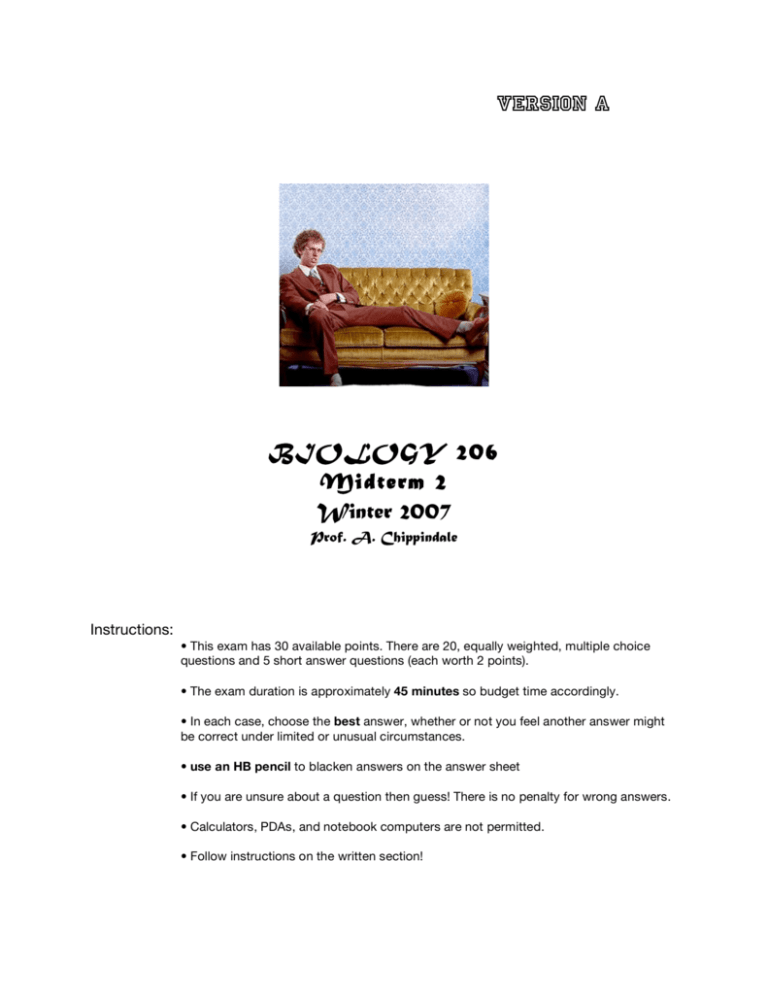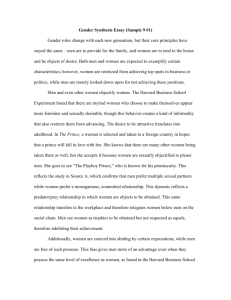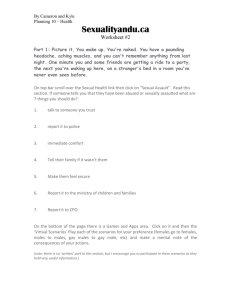2007 Midterm #2
advertisement

VERSION A BIOLOGY 206 Midterm 2 Winter 2007 Prof. A. Chippindale Instructions: • This exam has 30 available points. There are 20, equally weighted, multiple choice questions and 5 short answer questions (each worth 2 points). • The exam duration is approximately 45 minutes so budget time accordingly. • In each case, choose the best answer, whether or not you feel another answer might be correct under limited or unusual circumstances. • use an HB pencil to blacken answers on the answer sheet • If you are unsure about a question then guess! There is no penalty for wrong answers. • Calculators, PDAs, and notebook computers are not permitted. • Follow instructions on the written section! Biology 206 w2007 Second Midterm 2 1) The only direct effect of sex is … a) it reduces linkage disequilibrium. b) it generates genetic variety. c) it creates anisogamy. d) it creates isogamy. 2) Anisogamy probably arose because of: a) a tradeoff between size and number of gametes. b) a positive correlation between gamete size and zygote survival. c) division of labour between mates in offspring care. d) both A & B. e) All of the above. 3) Dunbrack et. al. used Tribolium beetles to test for benefits to sexual recombination. In each of their experiments, sexual beetles displaced simulated (non-adapting) asexual beetles over evolutionary time, despite being at a threefold disadvantage. The most likely explanation for this result is: a) There was standing genetic variation for insecticide resistance in the population; sex allowed resistance genes to come together in the same individuals. b) Though rare, new beneficial resistance mutations arose commonly enough to evolve resistance to the insecticide; sex allowed these to escape background selection and move to high fitness genotypes. c) Deleterious mutations build up rapidly, especially under stress; sex helped to stop Muller’s Ratchet, whereas the asexual beetles’ fitness declined steadily. d) Exposure of deleterious recessive alleles in the asexual lines reduced their fitness; sex prevented inbreeding depression. 4) True or False? Linkage disequilibrium is a non-random association between alleles at different loci, and is always caused by the physical connection of the two loci (e.g., on same chromosome) a) TRUE. b) FALSE. 5) The estimated age of the CCR5-32 allele based on linkage analysis with nearby markers by Stephens et al. suggests that the deletion is at high frequency in northern Europe because … a) HIV is not a new disease and there has been continuous selection for resistance to HIV infection for at least several hundred years. b) the allele became common in the Ashkenazy Jew population by genetic drift, and has spread to several N. European populations by migration. c) it hitchhiked to high frequency with selection on other tightly-linked loci on the second chromosome. d) it coincidentally conferred resistance to smallpox or bubonic plague in northern Europe several hundred years ago. Biology 206 w2007 Second Midterm 3 6) In a typical QTL analysis, such as that performed on Mimulus (monkey flowers) by Bradshaw et al., low LOD scores may be obtained even when there are QTL and large sample sizes in the cross if… a) the QTL have relatively weak influence on the phenotype. b) the marker loci are few and widely-distributed . c) the phenotypes of the two parental species are very similar. d) both (a) and (b). d) all of the above. 7) An experimenter selects for greater eyespan in the hammerhead fly, D. heteroneura. If the population has an eyespan of 1.25mm after selection, the heritability of the trait is 0.50, and the selected group had an eyespan of 1.50 mm, and, what was the eyespan of the population before selection? a) 1.00 mm. b) 1.125 mm. c) 1.25 mm. d) 1.75 mm. 8) Studies by Lively and colleagues demonstrated a relationship between the occurrence of sexual snails and infection by Microphallus, a trematode. The researchers captured parasites and common snail clones from the same lakes, and infected snails with either (1) their local parasite or (2) a foreign parasite. What did they see and what did it suggest to them? a) Trematodes were better at infecting foreign snails, suggesting that local snails had evolved defenses against infection. b) Trematodes were better at infecting local snails, suggesting specific adaptation to the common snail clone. c) There was no discernable difference between treatments, suggesting that the dynamics of hostparasite evolution are controlled by a multi-locus interaction. d) There was no discernable difference between treatments, which the authors attributed to high levels of gene flow between lakes generated by duck movements. 9) Hosken asked a simple question about bat social structure and sperm competition/testis size. Why did he especially need to employ Felsenstein’s methods? a) Bat species were divided into a few major clades that had similar roosting behaviour and may not be phylogenetically independent. b) Felsenstein knew that bats face a strong tradeoff between brain and testis tissue investment and developed a correction. c) Male bats have seasonal expression of sexual characters, and Felsenstein’s approach corrects for this. d) Bats become torpid in winter. Felsenstein’s methods adjust for variable activity periods in different species Biology 206 w2007 Second Midterm 4 10) True or False? The large relative size of human testes suggests an evolutionary history of promiscuity similar to what we see in our sister species, the chimpanzee, today. a) TRUE. b) FALSE. 11) Jacking in coho salmon is believed to represent: a) a plastic, equal-fitness alternative male strategy. b) a frequency-dependent genetic polymorphism. c) a ‘best of a bad job’ adaptive response. d) a way of parasitizing hooknose males’ parental care. 12) Welch et al. split bunches of grey tree frog eggs and fertilized them with sperm from either short- or long-calling males. They found that long-calling males’ offspring displayed higher viability and growth rate as tadpoles and young adults. These results are consistent with: a) runaway sexual selection. b) chase away sexual selection. c) good genes. d) preexisting sensory bias. e) all of the above 13) A spandrel is: a) A species of snail Darwin was fond of. b) An English lap dog. c) An architectural element. d) A wrench used by plumbers. 14) In Lizardland, if a rocky outcrop has a high frequency of harem-holding, dominant orangethroated males, the rock-paper-scissors game will favour… a) Monogamous blue-throated males. b) Sneaker yellow-throated males. c) Hyper-dominant green-throated males. d) No other male type. The strategy cannot be invaded once it is common. 15) In the tephritid fly Zonosemata / jumping spider example, what evidence was presented that the fly’s unusual appearance and behaviour had evolved to specifically deter jumping spider predation? a) Houseflies, tephritid flies, and tephritid flies with housefly wings were all quickly consumed by other predators (e.g., other types of spiders, mantises). b) Jumping spiders retreat from houseflies with Zonosemata wings attached, but not from Zonosemata with housefly wings attached. c) Jumping spiders do not retreat from houseflies with Zonosemata wings attached, but do retreat from Zonosemata with housefly wings attached.. d) None. The investigators found that Zonosemata or sham-treated Zonosemata deter attack from both jumping spiders and a wide spectrum of other predators (i.e., they are Batesian mimics). Biology 206 w2007 Second Midterm 16) True or False. Bowerbird males decorate huts, maypoles and other structures they build with treasures, tend to a lawn, and dance to attract females. They especially make use of blue objects, even human trash. a) True b) False 17) Sarah Blaffer Hrdy studied langurs, a primate species in which females exhibit a high degree of polyandry. Hrdy suggested that the benefit to this form of polygamy is: a) genetically diverse offspring. b) paternity confusion. c) trading up in genetic quality d) increased sexual stimulation & higher fertility. e) any or all of the above. 18) Apert syndrome is a paternally-transmitted single-nucleotide genetic disease. Studies suggest that the incidence of offspring inheriting the disease increases with paternal age because… a) mutations of all kinds steadily increase with age and number of sperm produced by men. b) Apert sperm are better competitors, so they fertilize a statistically greater number of eggs. c) mutant Apert stem cells divide faster than normal stem cells. d) both (a) and (b). 19) In Heather Procter’s study of water mites, she related male behaviour to the hunting behaviour of females, suggesting preexisting sensory bias. While this was a compelling study, what was the biggest problem with her conclusion? a) Female mites hunt but also accept nuptial gifts from males. b) There was no evidence that evolution of the net-stance preceded trembling by males. c) The net stance is related to female hunting and not mating. d) Trembling by males is found in species that lack the net-stance. 20) When Nancy Burley added ornaments (e.g., leg bands) to male zebra finches, she found that this altered their paternal behaviour so the males became philanderers and poor fathers. In response to reduced male nest care, females paired with these males… a) elicited extra-pair copulations and accepted parenting help from neighbouring males. b) remained faithful, increased parenting effort, and invested more in eggs from these males. c) ‘divorced’ the males and found new partners to nest with. d) ‘divorced’ the males and found new partners to nest with, but still copulated frequently with the attractive mate they originally nested with. 5 Biology 206 w2007 6 Second Midterm Short Ans w er Quest io ns Full sentences are not required. Keep answers as brief and concise as possible. Please restrict answers to the space provided. We will not grade excessive departures from the allotted space. sa1) The Bell Curve sparked a wave of controversy over the genetics of human intelligence. What simple (but impossible) experiment would we have to do to test Murray & Herrnstein’s assertion that there is a genetic difference in IQ between African and European Americans? (2pt) __________________________________________________________________________ __________________________________________________________________________ __________________________________________________________________________ Pop 1 Pop 2 Pop 3 Pop 4 Leaf Dry Mass (g) sa2) A botanist working on a species that ranges from Oregon all the way to Baja California along the west coast is interested in energetic tradeoffs between leaf size and flower size. She collects seeds from 4 sites up and down the coast and returns to Queen’s, where she plants them in the Phytotron on top of BioSciences. After the plants have grown, she measures flowers and leaves on 6 plants from each population. Her data are shown above, with a best-fit line drawn through all of them. Do the data support her hypothesis? Why or why not? (2pt) __________________________________________________________________________ __________________________________________________________________________ __________________________________________________________________________ Biology 206 w2007 Second Midterm 7 sa3) Elena and Lenski were surprised to find that, after 10,000 generations of adaptation to a simple laboratory environment, E. coli clones pulled from the population differed, on average, by 4% in fitness. They suggested three potential explanations for this result: (1) Fisher’s Fundamental Theorum, (2) Mutation-Selection Balance, and (3) Changing Environments. Which one did they champion in the end? (2pt). __________________________________________________________________________ __________________________________________________________________________ __________________________________________________________________________ sa4) Angus Bateman had a particular view of sexual selection and male and female gender roles, forged from observations of fruit flies. Do observations from organisms like pipefish and seahorses confirm, refute or modify the Bateman principle, and how? (2pt) __________________________________________________________________________ __________________________________________________________________________ __________________________________________________________________________ sa5) With respect to attraction, and changes in attraction, what is the key difference between Runaway Sexual selection and Chase Away sexual selection? (2pt) __________________________________________________________________________ __________________________________________________________________________ __________________________________________________________________________









